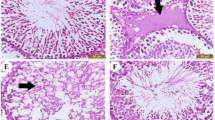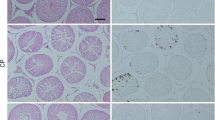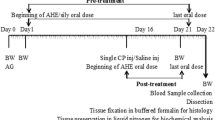Abstract
Cisplatin (CIS) is an antineoplastic drug able to produce free radicals that are capable to induce various side effects in different tissues. Hydrogen sulfide (H2S) has notable antioxidant, anti-apoptotic, and anti-inflammatory effects in different systems but its role in male reproductive system is not fully understood. In the present research, the effect of sodium hydrosulfide (NaHS) on cisplatin-induced testicular toxicity in male rats was studied. Thirty-two Sprague–Dawley rats were equally divided into 4 groups. The control group was treated with normal saline by intraperitoneal injection. The NaHS group received NaHS (200 μg/kg/day) intraperitoneally for 15 days. The CIS group received single dose of cisplatin (5 mg/kg) intraperitoneally, while the combination of CIS and NaHS was given to the CIS+ NaHS group. At the end of the study, body and testicular weights, plasma testosterone level, histological and morphometrical alterations, inflammation via IL-1β protein, lipid peroxidation, and activity of antioxidant enzymes (including glutathione peroxidase, superoxide dismutase, and catalase) of testicular tissue were evaluated. CIS injection revealed a significant decrease (p < 0.01) in body and testis weights, plasma testosterone concentration, diameter of seminiferous tubules, germinal epithelium thickness, the number of Sertoli cells, spermatogonia and spermatocyte, Johnsen’s testicular score, and testicular antioxidant enzymes, whereas it caused a significant increase (p < 0.01) in lumen diameter of the seminiferous tubules, level of lipid peroxidation, and IL-1β protein expression when compared with the control group. NaHS administration to CIS-treated rats provided marked improvement (p < 0.05) in all biochemical, histological, and morphometrical changes induced by CIS. The beneficial effects of NaHS were mediated, at least partly, by its antioxidant and anti-inflammatory properties.




Similar content being viewed by others
References
Abdel-Daim MM, Abushouk AI, Donia T, Alarifi S, Alkahtani S, Aleya L, Bungau SG (2019a) The nephroprotective effects of allicin and ascorbic acid against cisplatin-induced toxicity in rats. Environ Sci Pollut Res Int 26(13):13502–13509. https://doi.org/10.1007/s11356-019-04780-4
Abdel-Daim MM, Aleya L, El-Bialy BE, Abushouk AI, Alkahtani S, Alarifi S, Alkahtane AA, Albasher G, Ali D, Almeer RS, Al-Sultan NK, Alghamdi J, Alahmari A, Bungau SG (2019b) The ameliorative effects of ceftriaxone and vitamin E against cisplatin-induced nephrotoxicity. Environ Sci Pollut Res Int 26(15):15248–15254. https://doi.org/10.1007/s11356-019-04801-2
Abdellatief SA, Galal AA, Farouk SM, Abdel-Daim MM (2017) Ameliorative effect of parsley oil on cisplatin-induced hepato-cardiotoxicity: a biochemical, histopathological, and immunohistochemical study. Biomed Pharmacother 86:482–491. https://doi.org/10.1016/j.biopha.2016.12.038
Abdel-Moneim AE, Othman MS, Ahmed M, Aref AM (2014) Azadirachta indica attenuates cisplatin-induced nephrotoxicity and oxidative stress. Biomed Res Int: Article ID 647131, 11 pages. https://doi.org/10.1155/2014/647131
Ahmad A, Druzhyna N, Szabo C (2016) Delayed treatment with sodium hydrosulfide improves regional blood flow and alleviates cecal ligation and puncture (clp)-induced septic shock. Shock 46(2):183–193. https://doi.org/10.1097/SHK.0000000000000589
Almeer RS, Abdel Moneim AE (2018) Evaluation of the protective effect of olive leaf extract on cisplatin-induced testicular damage in rats. Oxidative Med Cell Longev: Article ID 8487248. 11 pages. https://doi.org/10.1155/2018/8487248
Amin A, Abraham C, Hamza AA, Abdalla ZA, Al-Shamsi SB, Harethi SS, Daoud S (2012) A standardized extract of Ginkgo biloba neutralizes cisplatin-mediated reproductive toxicity in rats. J Biomed Biotechnol: 11 pages, article 362049. https://doi.org/10.1155/2012/362049
Anand H, Misro MM, Sharma SB, Prakash S (2015) Protective effects of Eugenia jambolana extract versus N-acetyl cysteine against cisplatin-induced damage in rat testis. Andrologia 47(2):194–208. https://doi.org/10.1111/and.12247
Ateşşahin A, Sahna E, Türk G, Ceribaşi AO, Yilmaz S, Yüce A, Bulmuş O (2006) Chemoprotective effect of melatonin against cisplatin-induced testicular toxicity in rats. J Pineal Res 41(1):21–27. https://doi.org/10.1111/j.1600-079X.2006.00327.x
Bradford MM (1976) A rapid and sensitive method for the quantitation of microgram quantities of protein utilizing the principle of protein-dye binding. Anal Biochem 72:248–254. https://doi.org/10.1006/abio.1976.9999
Çeribaşı AO, Sakin F, Türk G, Sönmez M, Ateşşahin A (2012) Impact of ellagic acid on adriamycin-induced testicular histopathological lesions, apoptosis, lipid peroxidation and sperm damages. Exp Toxicol Pathol 64(7–8):717–724. https://doi.org/10.1016/j.etp.2011.01.006
Chirino YI, Pedraza-Chaverri J (2009) Role of oxidative and nitrosative stress in cisplatin-induced nephrotoxicity. Exp Toxicol Pathol 61(3):223–242. https://doi.org/10.1016/j.etp.2008.09.003
Corsello T, Komaravelli N, Casola A (2018) Role of hydrogen sulfide in NRF2- and sirtuin-dependent maintenance of cellular redox balance. Antioxidants 7(10):E129. https://doi.org/10.3390/antiox7100129
Eid AH, Abdelkader NF, Abd El-Raouf OM, Fawzy HM, El-Denshary ES (2016) Carvedilol alleviates testicular and spermatological damage induced by cisplatin in rats via modulation of oxidative stress and inflammation. Arch Pharm Res 39(12):1693–1702. https://doi.org/10.1007/s12272-016-0833-6
Endo F, Manabe F, Takeshima H, Akaza H (2003) Protecting spermatogonia from apoptosis induced by doxorubicine using the luteinizing hormone-releasing hormone analog leuprorelin. Int J Urol 10:72–77. https://doi.org/10.1046/j.1442-2042.2003.00572.x
Fallahzadeh AR, Rezaei Z, Rahimi HR, Barmak MJ, Sadeghi H, Mehrabi S, Rabani SM, Kashani IR, Barati V, Mahmoudi R (2017) Evaluation of the effect of pentoxifylline on cisplatin-induced testicular toxicity in rats. Toxicol Res 33(3):255–263. https://doi.org/10.5487/TR.2017.33.3.255
Farsani BE, Karimi S, Mansouri E (2018) Pravastatin attenuates testicular damage induced by doxorubicin - a stereological and histopathological study. J Basic Clin Physiol Pharmacol 30(1):103–109. https://doi.org/10.1515/jbcpp-2018-0073
García MM, Acquier A, Suarez G, Gomez NV, Gorostizaga A, Mendez CF, Paz C (2012) Cisplatin inhibits testosterone synthesis by a mechanism that includes the action of reactive oxygen species (ROS) at the level of P450scc. Chem Biol Interact 199(3):185–191. https://doi.org/10.1016/j.cbi.2012.08.012
Guo R, Wu K, Chen J, Mo L, Hua X, Zheng D, Chen P, Chen G, Xu W, Feng J (2013) Exogenous hydrogen sulfide protects against doxorubicin-induced inflammation and cytotoxicity by inhibiting p38MAPK/NFκB pathway in H9c2 cardiac cells. Cell Physiol Biochem 32(6):1668–1680. https://doi.org/10.1159/000356602
Howell SJ, Shalet SM (2001) Testicular function following chemotherapy. Hum Reprod Update 7:363–369. https://doi.org/10.1093/humupd/7.4.363
Jahan S, Munawar A, Razak S, Anam S, Ul Ain Q, Ullah H, Afsar T, Abulmeaty M, Almajwal A (2018) Ameliorative effects of rutin against cisplatin-induced reproductive toxicity in male rats. BMC Urol 18:107. https://doi.org/10.1186/s12894-018-0421-9
Karimi A, Absalan F, Khorsandi L, Valizadeh A, Mansouri E (2017) Sodium hydrogen sulfide (NaHS) ameliorates alterations caused by cisplatin in filtration slit diaphragm and podocyte cytoskeletal in rat kidney. J Nephropathol 6(3):150–156. https://doi.org/10.15171/jnp.2017.26
Khorsandi L, Orazizadeh M, Moradi-Gharibvand N, Hemadi M, Mansouri E (2017) Beneficial effects of quercetin on titanium dioxide nanoparticles induced spermatogenesis defects in mice. Environ Sci Pollut Res Int 24(6):5595–5606. https://doi.org/10.1007/s11356-016-8325-2
Kimura H (2013) Physiological role of hydrogen sulfide and polysulfide in the central nervous system. Neurochem Int 63:492–497. https://doi.org/10.1016/j.neuint.2013.09.003
Kimura H (2014) The physiological role of hydrogen sulfide and beyond. Nitric Oxide 41:4–10. https://doi.org/10.1016/j.niox.2014.01.002
Li L, Bhatia M, Moore PK (2006) Hydrogen sulphide-a novel mediator of inflammation? Curr Opin Pharmacol 6:125–129. https://doi.org/10.1016/j.coph.2005.10.007
Li G, Xie ZZ, Chua JM, Wong PC, Bian J (2015) Hydrogen sulfide protects testicular germ cells against heat-induced injury. Nitric Oxide 46:165–171. https://doi.org/10.1016/j.niox.2014.10.005
Liu Z, Han Y, Li L, Lu H, Meng G, Li X, Shirhan M, Peh MT, Xie L, Zhou S, Wang X, Chen Q, Dai W, Tan CH, Pan S, Moore PK, Ji Y (2013) The hydrogen sulfide donor, GYY4137, exhibits anti-atherosclerotic activity in high fat fed apolipoprotein E(−/-) mice. Br J Pharmacol 169:1795–1809. https://doi.org/10.1111/bph.12246
Lobb I, Zhu J, Liu W, Haig A, Lan Z, Sener A (2014) Hydrogen sulfide treatment ameliorates long-term renal dysfunction resulting from prolonged warm renal ischemia-reperfusion injury. Can Urol Assoc J 8:E413–E418. https://doi.org/10.5489/cuaj.1694
Mansouri E (2018) Effects of sodium hydrogen sulfide (a H2S donor) on acute kidney injury. J Nephropathol 7(1):1–3. https://doi.org/10.15171/jnp.2018.01
Mehrzadi S, Fatemi I, Malayeri AR, Khodadadi A, Mohammadi F, Mansouri E, Rashno M, Goudarzi M (2018) Ellagic acid mitigates sodium arsenite-induced renal and hepatic toxicity in male wistar rats. Pharmacol Rep 70(4):712–719. https://doi.org/10.1016/j.pharep.2018.02.007
Mercantepe T, Unal D, Tümkaya L, Yazici ZA (2018) Protective effects of amifostine, curcumin and caffeic acid phenethyl ester against cisplatin-induced testis tissue damage in rats. Exp Ther Med 15(4):3404–3412. https://doi.org/10.3892/etm.2018.5819
Mohammadnejad D, Abedelahi A, Soleimani-rad J, Mohammadi-roshandeh A, Rashtbar M, Azami A (2012) Degenerative effect of cisplatin on testicular germinal epithelium. Adv Pharm Bull 2(2):173–177. https://doi.org/10.5681/apb.2012.026
Nambu A, Kumamoto Y (1995) Effect of follicle-stimulating hormone (FSH) on protection or acceleration to recovery from spermatogenic damage induced by anti-cancer agents. (In Japanese). Nihon Hinyokika Gakkai Zasshi 86(7):1231–1239
Ning JZ, Li W, Cheng F, Rao T, Yu WM, Ruan Y, Yuan R, Zhang XB, Du Y, Xiao CC (2018) The protective effects of GYY4137 on ipsilateral testicular injury in experimentally varicocele-induced rats. Exp Ther Med 15(1):433–439. https://doi.org/10.3892/etm.2017.5417
Reddy KP, Madhu P, Reddy PS (2016) Protective effects of resveratrol against cisplatin-induced testicular and epididymal toxicity in rats. Food Chem Toxicol 91:65–72. https://doi.org/10.1016/j.fct.2016.02.017
Sherif IO, Abdel-Aziz A, Sarhan OM (2014) Cisplatin-induced testicular toxicity in rats: the protective effect of arjunolic acid. J Biochem Mol Toxicol 28(11):515–521. https://doi.org/10.1002/jbt.21593
Shokrzadeh M, Ahmadi A, Chabra A, Naghshvar F, Salehi F, Habibi E, Haghi-Aminjan H (2014) An ethanol extract of Origanum vulgare attenuates cyclophosphamide-induced pulmonary injury and oxidative lung damage in mice. Pharm Biol 52(10):1229–1236. https://doi.org/10.3109/13880209.2013.879908
Soni KK, Kim HK, Choi BR, Karna KK, You JH, Cha JS, Shin YS, Lee SW, Kim CY, Park JK (2016) Dose-dependent effects of cisplatin on the severity of testicular injury in Sprague Dawley rats: reactive oxygen species and endoplasmic reticulum stress. Drug Des Devel Ther 10:3959–3968. https://doi.org/10.2147/DDDT.S120014
Sugiura Y, Kashiba M, Maruyama K, Hoshikawa K, Sasaki R, Saito K, Kimura H, Goda N, Suematsu M (2005) Cadmium exposure alters metabolomics of sulfur-containing amino acids in rat testes. Antioxid Redox Signal 7:781–787. https://doi.org/10.1089/ars.2005.7.781
Wang J, Wang W, Li S, Han Y, Zhang P, Meng G, Xiao Y, Xie L, Wang X, Sha J, Chen Q, Moore PK, Wang R, Xiang W, Ji Y (2018) Hydrogen sulfide as a potential target in preventing spermatogenic failure and testicular dysfunction. Antioxid Redox Signal 28(16):1447–1462. https://doi.org/10.1089/ars.2016.6968
Yokoi K, Mayi ZK (2004) Organ apoptosis with cytotoxic drugs. Toxicology 290:78–85
Yoshida A, Miura K, Shirai M (1997) Evaluation of seminiferous tubule scores obtained through testicular biopsy examinations of nonobstructive azoospermic men. Fertil Steril 68(3):514–518. https://doi.org/10.1016/s0015-0282(97)00239-2
Zhao YM, Gao LP, Zhang HL, Guo JX, Guo PP (2014) Grape seed proanthocyanidin extract prevents DDP-induced testicular toxicity in rats. Food Funct 5(3):605–611. https://doi.org/10.1039/c3fo60486a
Zhou J, Lv XH, Fan JJ, Dang LY, Dong K, Gao B, Song AQ, Wu WN (2018) GYY4137 promotes mice feeding behavior via arcuate nucleus sulfur-sulfhydrylation and ampk activation. Front Pharmacol 9:966. https://doi.org/10.3389/fphar.2018.00966
Zhu X, Jiang X, Li A, Zhao Z, Li S (2017) S-Allylmercaptocysteine attenuates cisplatin-induced nephrotoxicity through suppression of apoptosis, oxidative stress, and inflammation. Nutrients 9(2):E166. https://doi.org/10.3390/nu9020166
Funding
This research project was supported by a grant from the Deputy of Research and Technology Development of the Ahvaz Jundishapur University of Medical Sciences (Grant No. 96s62).
Author information
Authors and Affiliations
Corresponding author
Ethics declarations
All procedures were done in accordance with the ethics committee of Ahvaz Jundishapur University of Medical Sciences.
Conflict of interest
The authors declare that they have no conflict of interest.
Additional information
Responsible editor: Mohamed Abdel-Daim
Publisher’s note
Springer Nature remains neutral with regard to jurisdictional claims in published maps and institutional affiliations.
Rights and permissions
About this article
Cite this article
Azarbarz, N., Shafiei Seifabadi, Z., Moaiedi, M.Z. et al. Assessment of the effect of sodium hydrogen sulfide (hydrogen sulfide donor) on cisplatin-induced testicular toxicity in rats. Environ Sci Pollut Res 27, 8119–8128 (2020). https://doi.org/10.1007/s11356-019-07266-5
Received:
Accepted:
Published:
Issue Date:
DOI: https://doi.org/10.1007/s11356-019-07266-5




